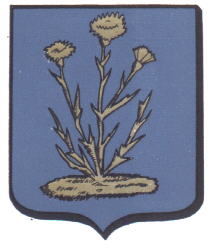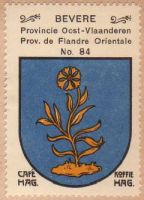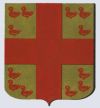Bevere: Difference between revisions
Jump to navigation
Jump to search
Knorrepoes (talk | contribs) m (Text replacement - "↵{{media}}↵↵'''Literature''': Servais, 1955↵↵[[Category:" to " '''Literature''': Servais, 1955 {{be1}} {{media1}} [[Category:") Tags: Mobile edit Mobile web edit |
Knorrepoes (talk | contribs) No edit summary |
||
| Line 1: | Line 1: | ||
{{ | {| class="wikitable" | ||
''' | |- style="vertical-align:top;" | ||
|[[File:bevere.jpg|center|300 px|alt=Wapen van {{PAGENAME}}/Arms (crest) of {{PAGENAME}}]] | |||
| | |||
'''Country''' : Belgium [[File:Belgium.jpg|60 px|right]]<br><br><br> | |||
'''Province''' : <br>[[Oost-Vlaanderen]][[File:oostvlaanderen.jpg|60 px|right]]<br><br><br> | |||
'''Incorporated into :''' | |||
* 1964 [[Oudenaarde]] | |||
<br> | |||
{{#display_map:50.8509,3.5953|width=250|height=250|zoom=7}} | |||
|} | |||
{| class="wikitable" | |||
|+Official blazon | |||
|- | |||
|'''Dutch''' | |||
| | |||
*(1818) Van lazuur beladen met een korenbloem staande op een terras alles van goud. | *(1818) Van lazuur beladen met een korenbloem staande op een terras alles van goud. | ||
*(1844) Een blauw veld, met eene gulden gebladerde koornbloem, groeijende ook op een gulden heuvel. | *(1844) Een blauw veld, met eene gulden gebladerde koornbloem, groeijende ook op een gulden heuvel. | ||
|- | |||
|'''English''' | |||
| blazon wanted | |||
|} | |||
===Origin/meaning=== | ===Origin/meaning=== | ||
| Line 16: | Line 29: | ||
The arms show a cornflower as symbol for the agriculture, the main means of income in the 19<sup>th</sup> century. The colours are the Dutch national colours, as in 1818 Belgium was part of the Netherlands. If no historical colours were known, the national colours (blue and gold) were used. Strangely, the colours are opposite to the natural colours, as cornflowers are blue. | The arms show a cornflower as symbol for the agriculture, the main means of income in the 19<sup>th</sup> century. The colours are the Dutch national colours, as in 1818 Belgium was part of the Netherlands. If no historical colours were known, the national colours (blue and gold) were used. Strangely, the colours are opposite to the natural colours, as cornflowers are blue. | ||
<gallery widths=250px heights=200px perrow=0> | |||
File:Bevere.hagbe.jpg|alt=Wapen van Bevere/Arms (crest) of Bevere|The arms in the [[Koffie Hag Belgium|Koffie Hag/Café Hag albums]] +/- 1930 | |||
</gallery> | |||
[[Civic Heraldry Literature - Belgium|'''Literature''']]: Servais, 1955 | [[Civic Heraldry Literature - Belgium|'''Literature''']]: Servais, 1955 | ||
Revision as of 08:17, 6 May 2023
|
Country : Belgium Province : Oost-Vlaanderen Incorporated into :
|
| Dutch |
|
| English | blazon wanted |
Origin/meaning
The arms were granted on August 4, 1818 and confirmed on October 9, 1844.
The arms show a cornflower as symbol for the agriculture, the main means of income in the 19th century. The colours are the Dutch national colours, as in 1818 Belgium was part of the Netherlands. If no historical colours were known, the national colours (blue and gold) were used. Strangely, the colours are opposite to the natural colours, as cornflowers are blue.
The arms in the Koffie Hag/Café Hag albums +/- 1930
Literature: Servais, 1955
This page is part of the Belgium heraldry portal/ Belgische overheidswapens/ Armorial de Belgique
|
|






